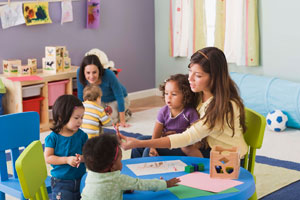Information for Schools & Childcare Providers
exclamation square light iconWhat to Know This Flu Season
Flu and COVID-19 are both contagious respiratory illnesses, but they are caused by different viruses. While it’s not possible to say what will happen, it’s likely that flu viruses and the virus that causes COVID-19 will both spread this fall and winter.
Protect yourself, your family, and your community against flu this fall and winter by getting a flu vaccine. Also follow other CDC recommendations to protect yourself from both flu and COVID-19.
The Centers for Disease Control and Prevention (CDC) recognizes that school administrators, teachers, staff, and parents are concerned about influenza (flu), particularly its effects on children. Educators and staff can help slow the spread of respiratory illnesses like colds, enterovirus D68 and influenza (flu). On this page, you will find information on preventing the flu as well as materials and tools for schools.
Influenza causes more hospitalizations among young children than any other vaccine-preventable disease. The single best way to protect against seasonal flu and its potential severe complications is for children to get a seasonal influenza vaccine each year. Flu vaccination is recommended for all children aged 6 months and older. Making healthy choices at school and at home can help prevent the flu and spreading flu to others.
Encourage children, parents, and staff to take the following everyday preventive actions to prevent flu pdf icon[2MB, 2 pages]:
- Stay home when you are sick. If possible, stay home from work, school, and errands when you are sick. You will help prevent others from catching your illness. Avoid close contact with people who are sick.
- Avoid touching your eyes, nose, or mouth. Germs spread this way.
- Clean and disinfect surfaces or objects. Clean and disinfect frequently touched surfaces at home, work or school, especially when someone is ill.
Resources on Common Flu Topics for School Administrators, Teachers, Staff, and Parents
General Information about Flu :
Other CDC Resources
- Supplemental Interim Guidance for School Administrators Associated with Possible Outbreaks of H3N2 Variant Influenza Virus (“H3N2v”)
- Good Health Habits for Preventing Seasonal Flu
- Flu Information for Parents
- Children, the Flu, and the Flu Vaccine
- Protecting Against the Flu: Advice for Caregivers of Children Less Than 6 Months Old
- School-Located Vaccination Clinics: Forms and Contact Letters
Print Resources
- Print Resources for Parents
- The Flu: A Guide for Parents Factsheet pdf icon[566 KB, 2 pages, 8.5″ x 11″]
External Resources
- Keep Flu Out of Schoolexternal icon
- Center for Health and Health Care in Schools (CHHCS): Flu Season and Schoolsexternal icon
- The Shot by Shot Project: Gigi’s Storyexternal icon
- National Foundation for Infectious Diseases: Flu Fighters Coloring books pdf icon[9.13 MB, 14 pages]external icon
School Materials and Posters

Coloring Book PDF: “Are you a flu fighter?” Englishexternal icon [8.3 MB, 14 pages], “Eres un luchador contra la influenza?” Spanishexternal icon [4 MB, 14 pages]

“It’s a SNAP”external icon
This toolkit provides activities for school administrators, teachers, students, and others to help stop the spread of germs in schools. For more information, visit the hand cleaning section of the “It’s a SNAP” websiteexternal icon.

Kids can learn about health and hygiene at the Scrub Club™ web siteexternal icon. The site features a fun and educational animated Webisode with seven “soaper-heros” who battle nasty villains representing germs and bacteria. Kids learn the six key steps to proper handwashing through a webisode, a handwashing song, interactive games, and activities for kids. Educational materials for teachers are also available to download.



